En-Gendering Monodrama: Training days at The Centre for Psychophysical Performance Research, University of Huddersfield. 5-day intensive training with Dr Ben Spatz and Ilona Krawczyk.
- Day 1, 10 January 2017
On the first day, we started our session with breathing exercises, and we went through some basics to explore positions of stillness. I contemplated that even when engaged in total stillness and trying to maintain a standing position, I am still in a dynamic state. Overall, I found it hard to switch off and completely focus on our work. It was my first day on the field after one month of “displacement”. As a consequence, most of my concentration and energy was devoted to reach an appropriate mindset, and I felt enormous muscular fatigue.
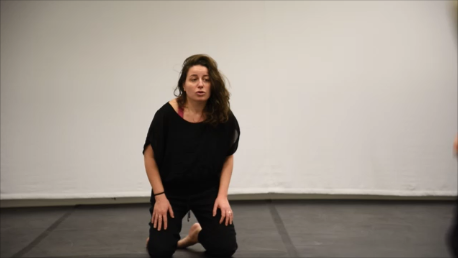

- Day 2, 11 January 2017
Ben introduced a sequence of exercises derived from Massimiliano Balduzzi’s physical training method for performers. In particular, we worked on the vertical axis and spent the first part of the training developing and refining several actions. Then, Ben asked me to integrate three more actions: run and stop, laughter and free gestures. I spent the rest of the training session trying to technically refine the movements; one of the strategies I applied was that of intertwining each motion with an inner beat, inscribed it into a larger rhythmic unit. The passage from one action to the other was dictated initially by Ben’s clapping, and therefore needed to be as crisp and precise as possible. At the same time, Ben required me to elaborate the transitions among actions seamlessly, so that the passage from one to the other could be imperceptible. The more the actions came together, the more I felt that a story, a dramatic line of action, was spontaneously woven by the established rhythm of the movement. And yet, the requirement I was given was to perform the movements in a way as dry and polished as possible, leaving aside any storytelling. I found this section of the training very intense and helpful, as I could concentrate on technical details, repeat and practice them to my liking, without fearing to clash against the dramatic tempi of any imaginary scene. At the same time, the more automatism my body was able to create, the more I found myself thinking and studying each movement as part of an imaginary staging of Neither. One detail in particular was key to my research: the suggestion to play with an “invisible partner”, a key notion in Grotowskian theatre training, so that there is no solo performance without imagining ourselves in dialogue with an invisible other. This concept, to which I’ll return, informed my work in all following sessions. Overall, I felt myself more at ease with the space and the work, and I felt grateful for my resistance to muscular pain. I also developed quite rapidly the capacity to immerse myself in the context and to let go of physical and mental constrictions.
- Day 3, 12 January 2017
Two other performers, Ilona Krawczyk and Sióbhán Harrison, joined us in the studio, and we all undertook a sequential physical training, interacting and challenging each other’s reflexes and concentration skills. I found this part of the training extremely helpful and I found myself triggering a few processes undertaken during my opera acting training years ago in Italy and the USA. I liked in particular the sheer athleticism of the exercises, a quality that informs my singing and performative approach overall. We added vocalisation as part of the training and we all joined our voices in vocal improvisation, undertaking a smooth crescendo from gesture, to embedded vocal gestures, to improvised harmonies.
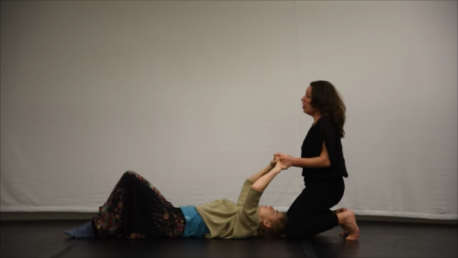
Ben and I then kept working on the sequence of actions, establishing specific levels of intensity to apply to the repetition of each pattern and its intermediate transitions. As I explored all the gamuts of the actions, I was required by Ben to introduce sung patterns from Neither. I found that it was physically demanding to add such a high register singing line on top of the sequence of actions. I integrated singing especially with the laughter exercise, trying to warm up the singing zone of my skull and bust. Yet the movements felt “out of tune” compared to the vocal challenge offered by Neither. I had to admit that the physical resistance produced by the intensity of the sequences went against my singing. Ben then suggested to introduce singing as a fifth action, simply transitioning from the other four; however, again, the high register of the vocal part would make it very difficult to engage with the intensity of the movement and its implied constant displacement. One thing I could feel though: that preparing my body to singing, no matter how sustained the line or the pitch was supposed to be, already made my physical engagement more focused and precise. I felt as if my body instinctively prepared for a ritual that was transcending me and my will.
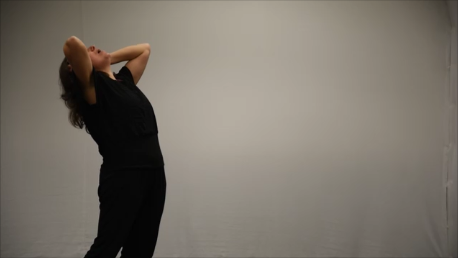
We left with me thinking about levels of intensity I could apply to the sequence, and I practiced on my own accordingly across a range from 0-10, which I noted down, associating progressive intensity of movements to each given degree.
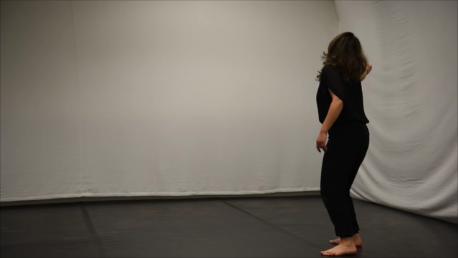
- Day 4, 13 January 2017
Ilona led the work session; three of us in the studio engaged with breathing exercises, walking, running, voicing, and a combination of all actions at different levels of intensity. We ended the session assuming a horizontal position on the floor and singing airs or songs exploring different positions from the newly found horizontal axis. I found that the embodied vocal training received on that occasion perfectly fulfilled and responded to my expectations in terms of consistency between physical work and vocal emission. I felt that I was stepping into a safer territory and enjoyed the sensation of “coming home to my embodied voice” at the end of the session.
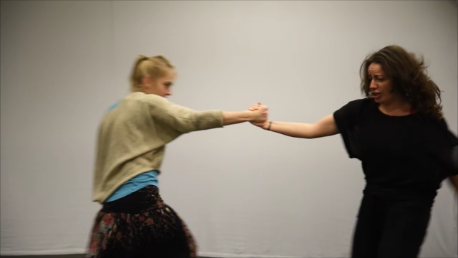
During the second half of the morning, Ben invited me to synthesize the sequence of exercises, going from technical and dry to free combination and improvisation based on the given actions. At a certain point, he required me to introduce at my liking a vocal part I’d feel more at ease with. Therefore, I started singing, even with some imperfections (could not remember my words!), the “suicide waltz” from La Voix humaine. Almost immediately, my physical sequences were infused by a more consistent flux. Singing definitely was bestowing on my actions a different fluidity, and the constraints dictated by the physical patterns in turn coloured my singing with a different quality. I was looking constantly for new positions, new angles, new possibilities, and scrutinizing through sequential gestures the drama implied by the text in ways that could add to the hysteria of the line.
This quality was emphasized when Ilona joined me in the space, invited by Ben to do so. I immediately felt that the ineluctable dialogue I had until then built exclusively with my invisible partner was casting its lights and shadows on a companion, a sister, a friend with whom I could finally share my pains as a stage figure and even my very self. I enjoyed the extemporary bond that the interaction with Ilona brought into our action and the resulting immersive experience. Again, all rhetorics of trust and assurance of the other I had experimented with colleagues on stage were triggered by Ilona’s knowing moves and my reactions to them.
Just as a final remark, physical training for opera singers is not only necessary, but beneficial to the developments of our bodies, not only as instruments of our voice, but also as performative spaces per se. Performance training explores the untapped potential of the singing body’s in-built dramatic agency, both vocally and physically. Not all physical training, however, could leave the warm up/practice/studio phase and move into the music studio seamlessly. Operatic singing is also a delicate balance of resistances and releases, and the intensity of that dialectic at times “short-circuits” with any other input, external or internal. Indeed practice is the key in any case.

Comments